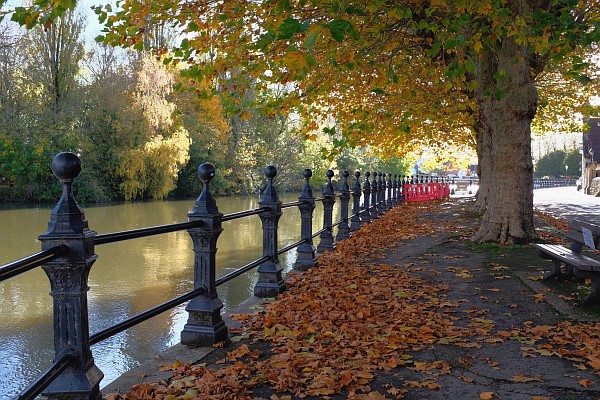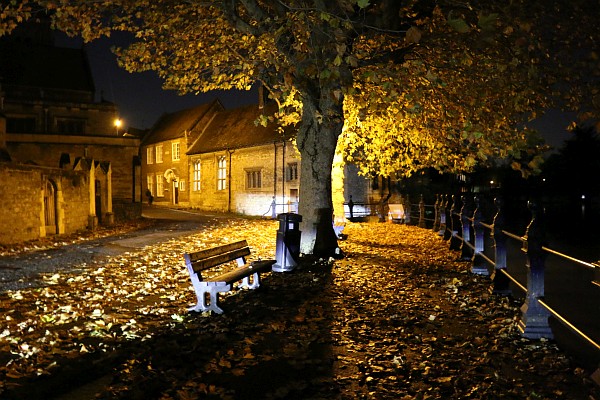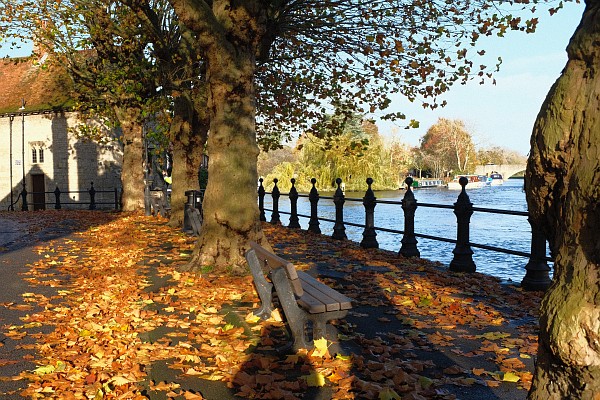
The Plane tree canopies at St Helen’s Wharf give shade during hot summer days.
The leaves fall during late October and November.

On some days, leaves carpet the pavement, half cover the road, and float and sink in the River Thames.

Then a worker from the council gathers all those leaves into several blue plastic bags to be taken away. Autumn leaves continue to fall.
I wonder if they make leaf mould? It amuses me. Monty Don on Gardeners World keeps recommending leaf mould to mix with compost. Well this is all very well if people have big gardens and can collect large quantities to compost. Even then one has to have enough space to compost them. I enquired of Harcout Arboretum if they sold leaf mould as they would have enough leaves to compost but they do not. I collect enough to make one black plastic bag full. They take over a year to compost down and do not make enough to make a difference to the garden.
The second picture is an excellent nighttime shot, and very difficult to do well.
Lovely pictures.
Apologies to hijack but many of you know stuff…
I am looking for other sites in Abingdon like Fitharrys Castle mound. Of course there’s The Abbey… Is there any other iron age or old sites near the leisure centre?
And there’s the woods in the corner of Drayton Field.
Does anyone know of any others and or more details of these?
Those woods are on the site in that field, but it actually extends far outside of the woods. Check out the aerial view on Google maps and you’ll spot crop marks.
Any book on local history should set you going though. There was a Roman Villa in Barton Court, Barrows at Barrow Hills, and an Anglo-saxon palace and church on Andersey Island.
Thank you James.
I did think I saw on this Blog a couple years ago about an Iron Age ditch/earthwork in the woods by the traffic lights for the leisure center? But…I’ll lookout for a book as well.
Daniel – the Abingdon Area Archaelogical and Historical Society are the people who will know – there is a catalogue of their research on their website https://www.aaahs.org.uk/archive/lost-abbey-2
The Lost Abbey book has some information about a wider area than the Abbey itself so is worth a look – if you can’t track down a copy during lockdown let me know, I have a stash!
Hester, that really is very great, thank you!
Have a look at Mieneke Cox’s excellent 4 volume ‘Story of Abingdon’ Daniel.
Volume 1 has 20 or so pages running from the jurassic through to the bronze age. There is a good map on page 27 which shows where prehistoric sites/finds have been identified.
From a quick look it appears to highlight:
– something around the morris gardens at top of drayton road
– something just north of the ock on the tithe farm estate
– something between caldecott and saxton road (about where the school is)
– Something by the thames at the end of saxton rd
– something in barton just off the radley road
– something (unsurprisingly) on barrow hills (just beyond daisybank)
Worth a read and has much more detail than i’ve outlined above
Marvellous, thank you Iain!
And if you can’t find them in the local bookshops, contact Tim Miller, Curator at the Abbey Buildings as they have some for sale there.